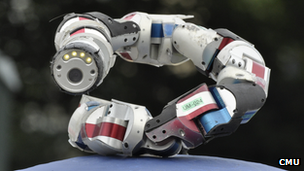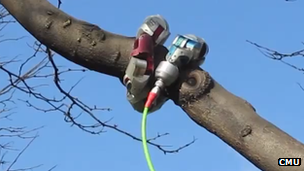Snake robot teams up with search-and-rescue dog in US
- Published
A dog carries the robot into the building in a pouch before it is released onto the ground
US researchers working on a snake-like robot have tested pairing it with a search-and-rescue dog.
The engineers sent two dogs fitted with harnesses containing the robot into a simulated collapsed building. The dogs then released the equipment, allowing the robot to wriggle free.
The researchers hope the technology will one day be used to locate people trapped in places inaccessible to dogs.
They are working to make the robot faster over rubble and other debris.
A video of the experiment, external has been posted online by Carnegie Mellon University's biorobotics lab.
Undulating joints
The test used the latest in a series of "modular snake robots" developed at the Pittsburgh-based research centre over the past decade.
The machines are designed to move through their surrounding environment by altering the angles of the links that chain together the different segments of their bodies.
This is designed to mirror the way their natural counterparts move through "lateral undulation", the synchronised muscle contractions used by snakes that allow them to appear to be gliding over the ground.

The Uncle Sam snake robot is one of several designs developed by the Carnegie Mellon lab
"Snake robots can use their many internal degrees of freedom to thread through tightly packed volumes, accessing locations that people and machinery otherwise cannot use," the researchers wrote.
"Moreover, these highly articulated devices can co-ordinate their internal degrees of freedom to perform a variety of locomotion capabilities that go beyond the capabilities of conventional wheeled and the recently developed legged robots."
The search-and-rescue test involved sending the dogs through a concrete pipe into the "collapsed building" at the Teex Disaster City emergency-response training centre in Texas.
They had been trained to bark when they found a point of interest. When they did so, the harnessed unlocked and deployed the robots, which then sent back a video feed via an attached wire linking the machine to its operators.
One of the problems faced by the researchers was that as the robot twisted itself about, the video also rotated, making it difficult to navigate the machine.

The snake robot was covered in a protective skin to prevent debris falling into its joints
However, the researchers told the BBC they had since come up with a software-based fix that ensured the video would always appear the right way up, whatever way the robot's camera was angled.
Previous tests by the team have involved launching one of its snake robots up a tree, external, which it gripped onto.
The machine was able to do this thanks to accelerometers built into its segments, which detected when it hit the tree's bark. This then triggered a coiling action, wrapping the robot's body around a branch to prevent it falling off.
Earlier robots have successfully navigated their way, external through the inside of pipes, crawled into storm drains and swum through water while protected by a "waterproof skin".
Sniff and search
Carnegie Mellon University is not the only organisation seeking to equip search-and-rescue dogs with the latest technology.
Berkshire-based firm Wood & Douglas has developed a video camera designed to be strapped onto a rescue dog's head to stream live footage back to base.

Previous tests have involved the robot wrapping itself round a branch after being thrown up into a tree
"Anything that can help an earthquake or disaster situation should be welcomed," said Chris Bignell, a spokesman for the company.
"We saw such a situation in Bangladesh last week where a building collapsed and a number of levels fell on top of each other.
"Whatever would speed up the process of being able to search everywhere in such an emergency is going to be helpful.
"But the advantage of still using rescue dogs is that they are trained to sniff out victims and locate them even if they can't see them, which you wouldn't get just by using a robot."
- Published21 September 2012
- Published23 July 2012